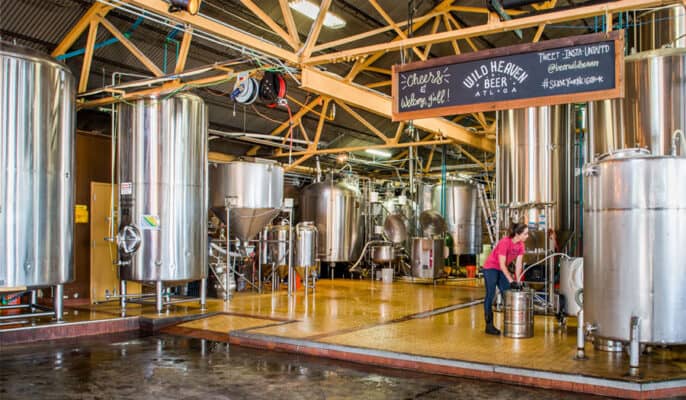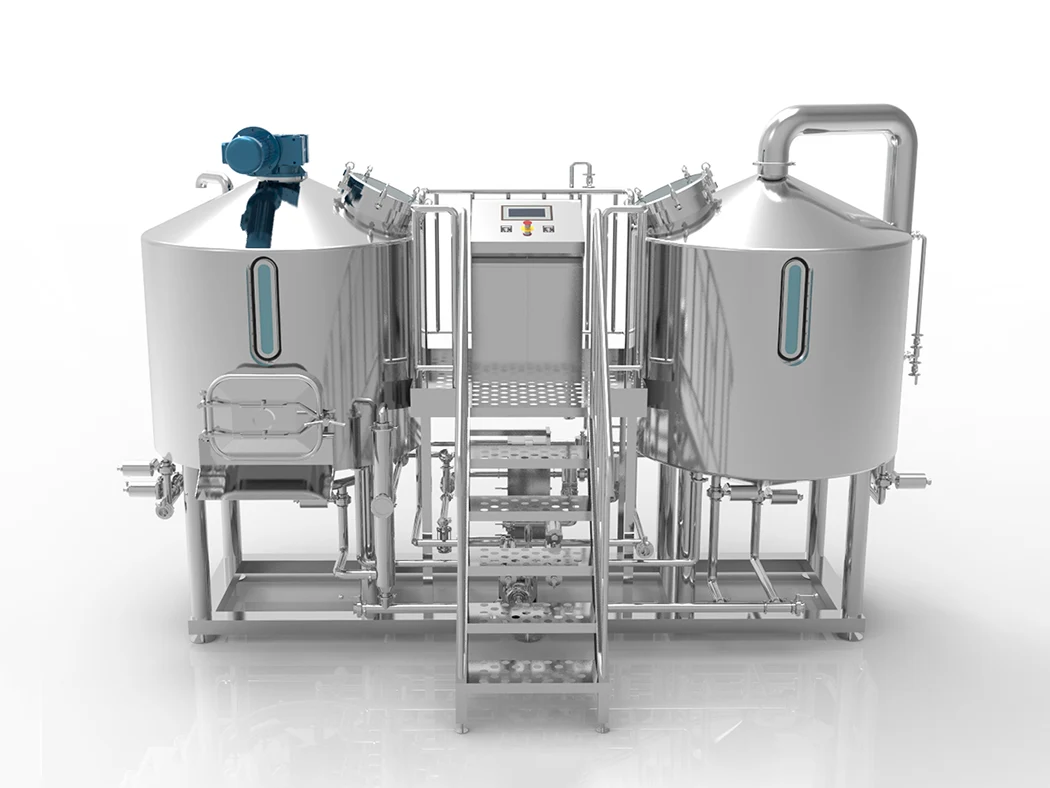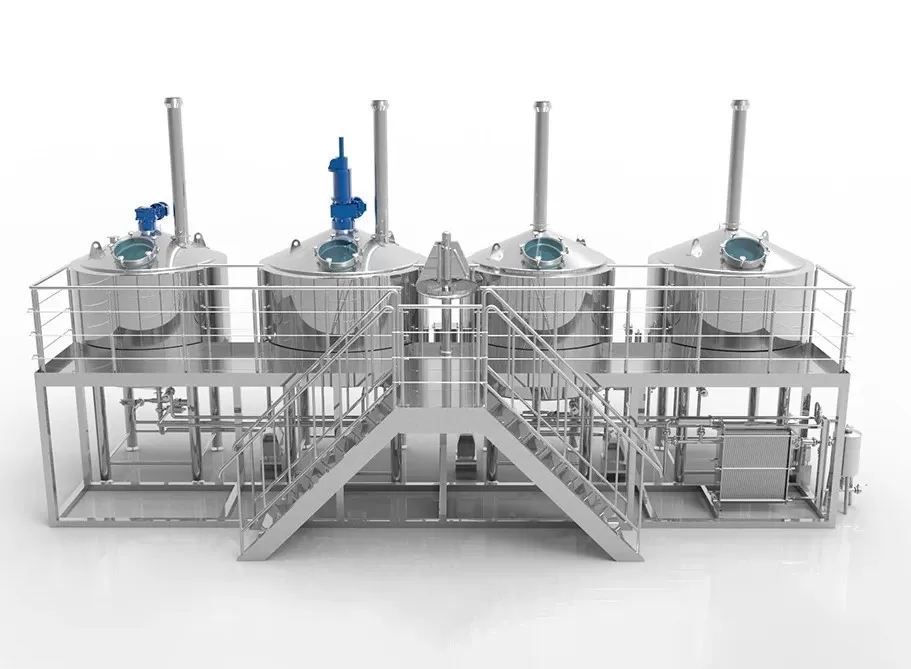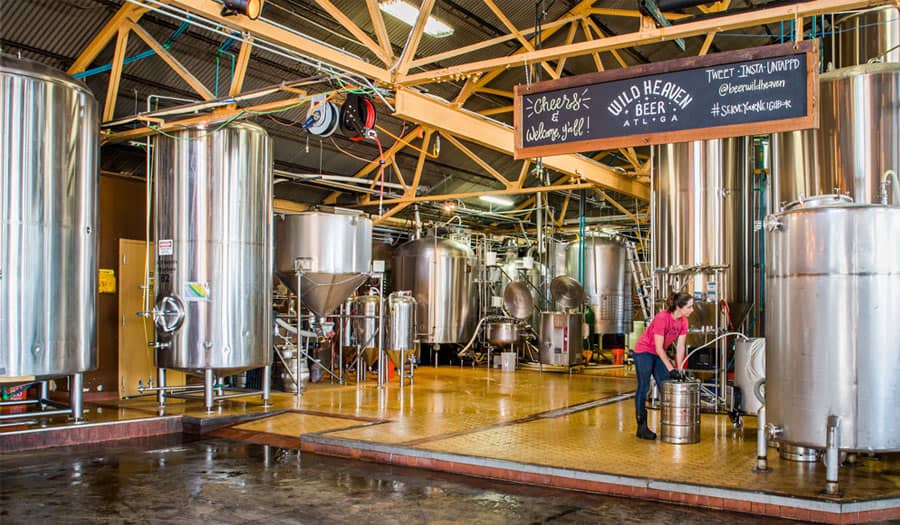Your dream пивоварня is ready—but the пивоварня choice stalls the plan. Wrong gear wastes сусло, money, and time. Choose a proven система пивоварения that fits space, budget, and growth.
For a microbrewery, start with a 5–15 bbl brewhouse system (2- or 3-судно) in нержавеющая сталь с сусловарочный тун, чайник, и hlt (hot liquor tank). Pair Унитанк ферментер sizes at 1–2× brewhouse volume, add a glycol чиллер, панель управления, бритые цистерны or conditioning in ферментеры, a теплообменник, and safe process piping. This is the equipment you’ll need for dependable оборудование для пивоварения.

Article Outline
- Что пивоварня size fits a микропивоварня and small партия goals?
- 2 vessel vs 3-vessel brewery system: which design suits the горячая сторона?
- Как горячая сторона choices shape пюре efficiency and сусло качество
- Ферментация essentials: choosing the right ферментер, Унитанк, и дрожжи strategy
- Do you need бритые цистерны, or condition in the ферментер?
- Utility map: glycol, чиллер, steam jackets или heating elements
- Controls, safety, and sanitary construction: details that drive uptime
- Packaging and service: кегирование, карбонизация, and clean beer line
- Floor plan & budget: opening a brewery without costly do-overs
- Масштабируемый пивоваренное оборудование packages for nano to промышленная пивоварня growth
- Вопросы и ответы
What brewhouse size fits a microbrewery and small batch goals?
For most first locations, a 5, 7, or 10 bbl brewhouse balances throughput and footprint. A 5 bbl setup fits starter brewpubs; 7–10 bbl suits higher-traffic taprooms and небольшие пивоварни that plan steady distribution. Larger пивоварни often include faster сусло knockout and bigger brewhouse vessels for efficiency.
A quick capacity sketch (assumes 80% brewhouse efficiency, two brew days weekly):
| Размер пивоварни | Weekly Beer (approx.) | Typical Fermenter Mix |
|---|---|---|
| 5 bbl | 40–60 bbl | Two 10 bbl + one 15 bbl Унитанк |
| 7 bbl | 60–84 bbl | Two 15 bbl + one 30 bbl ферментер |
| 10 bbl | 80–120 bbl | Two 20 bbl + one 40 bbl ферментер |
Pro tip: plan cellar volume 1.5–2× your brewhouse. That lets you закваска cleanly and avoid gridlock during busy weeks.
2 vessel vs 3-vessel brewery system: which design suits the hot side?
A 2 vessel configuration (MLT + чайник/whirlpool) reduces footprint and cost while still producing excellent крафтовое пиво. A 3-vessel layout (сусловарочный тун, лаутер/tuns, чайник/whirlpool) speeds turnarounds and improves multi-партия days by using separate vessels. Both choices work; match them to staffing and volume.
Comparison at a glance
| Дизайн | What it includes | Why choose it |
|---|---|---|
| Two-vessel | Пюре/lauter + чайник для заваривания/whirlpool | Smaller space, lower spend, simpler training |
| Three-vessel | Сусловарочный тун, лаутер/tuns, чайник/whirlpool | Быстрее горячее сусло turnover, higher throughput, easier stuck-mash recovery |
If you brew wide styles, a 3-vessel setup lifts flexibility; for tight budgets or nano startups, two vessels deliver strong value.
Scaling brewhouse automation? Review an automated beer brewing system package—knock-out speed, IO, and trending baked in.

How hot side choices shape mash efficiency and wort quality
On the горячая сторона, smooth grain hydration and consistent temperature steps protect extract and head retention. Proper rakes, screens, and flow paths promote clean run-off and sweet wort clarity. A plate теплообменник finishes the day, driving fast knock-out and safer wort chilling.
We size valves, manifolds, and process piping for low oxygen pickup. That keeps солод character bright and bitterness clean. A well-designed exchanger also shortens whirlpool time and improves hop utilization with steady горячее сусло flow.
Fermentation essentials: choosing the right fermenter, unitank, and yeast strategy
Most micro-breweries prefer conical нержавеющая сталь ферментер vessels for easy dumping, sampling, and closed transfers. A Унитанк (ferment + condition in one) saves floorspace and speeds changeovers. Pair volume to your brew length—e.g., a 10 bbl brewhouse works smoothly with 2×10 bbl and 1×20 bbl cellar.
Healthy дрожжи makes the beer. Choose pitch rates that match производство пива targets and consider a dedicated yeast propagation tank when you scale. Control temperature with insulated jackets and glycol loops for steady ферментация curves across ales and lagers.
Dial in fermentation? See our stainless steel conical fermenter options (racking arm, carb stone, PRV) and add a яркая емкость для пива when SKUs expand.
Do you need brite tanks, or condition in the fermenter?
Аквариумы Brite polish clarity, dial in карбонизация, and stage packaging without tying up your ферментеры. Many teams start with Юнитанки only, then add brite capacity as SKUs grow. If you frequently filter or serve lager, brite vessels help standardize results.
Small taprooms sometimes condition in the ферментер to conserve space. As volume rises, dedicated brite capacity protects schedule, especially for seasonal spikes and draft commitments.
Utility map: glycol, chiller, steam jackets or heating elements
Cooling drives control. A matched glycol чиллер and manifold keep tanks precise, even during peak production. We insulate lines and spec клапан stations for balanced flow to every jacket zone. For heating, choose steam jackets on the чайник for fast ramps and uniform boils, or electric heating elements where steam supply isn’t feasible.
Estimated heat load by brewhouse size (illustrative):
5 bbl | ██████████
7 bbl | ██████████████
10 bbl | ███████████████████
Right-sizing utilities protects quality and reduces utility spend.
Controls, safety, and sanitary construction: details that drive uptime
A clean, labeled панель управления with interlocks supports repeatable steps, safe starts, and quick training. We design NEMA-rated enclosures and color-coded indicators that guide the team through each stage—from dough-in to knockout.
Inside the skid, fully welded tri-clamp fittings and orbital joints maintain sanitary construction. Thoughtful CIP paths (yes, цип matters) shorten turnarounds, and ergonomic platforms reduce slips. The result: fewer stoppages and a happier brew crew.
Packaging and service: kegging, carbonation, and clean beer line
If your first sales are draft-heavy, dependable кегирование and target карбонизация levels keep accounts loyal. Maintain cold storage and schedule line cleaning for every beer line in your taproom and partner bars. As SKUs expand, plan for canning or bottling downstream of your cellar.
For broader distribution, map SKUs, labels, and QA checks before the first run. That discipline stabilizes quality as volumes rise.
Ready to package? Start with a space-efficient beer bottling machine before full canning lines.
Floor plan & budget: opening a brewery without costly do-overs
Opening a brewery is a construction puzzle: drains, power, venting, grain flow, and forklift paths must mesh. Keep raw materials forward, brewing supplies at hand, and filled бочонок/case egress clear. Plan room for future резервуары для пивоварения so growth doesn’t force a shutdown.
Avoid dead corners; give the cellar space for safe hoses and carts. A simple, right-sized layout beats a cramped “Tetris” any day.
Scalable brewery equipment packages for nano to commercial brewery growth
Start tight, think big. A turnkey brewing system eases setup today and scales toward a промышленная пивоварня tomorrow. We build brewpub-friendly 5–7 bbl skids that expand to multi-партия days with additional tuns and cellar volume. As orders build, step to commercial brewery equipment with faster knock-out, more jackets, and higher-capacity brewhouse system flow.
Prefer a modular path? Add дистилляционное оборудование to spin off spirits, or kombucha tanks once the taproom hums. Our teams integrate клапан panels, process piping, and utilities so upgrades slide in with minimal downtime.Explore a small batch path with оборудование для нано-пивоварни to validate recipes, train staff, and refine SOPs.

Example equipment list (your first order of battle)
Hot side
- 7–10 bbl пивоварня (two or three separate vessels)
- Сусловарочный тун with rakes and VFD pump
- Чайник/whirlpool with variable drive, steam jackets or electric heating elements
- Plate теплообменник sized for fast wort chilling
- Flow-balanced клапан tree and safe drains
Cold side
- Two 2×-size ферментер (e.g., 2×20 bbl) + one Унитанк
- One or two бритые цистерны
- Glycol header, чиллер, supply/return headers, and process piping
- Carb stone, spunding, sample valves, and CIP ball
Utilities & controls
- UL-labeled панель управления with alarms and trending
- Grain mill, auger, grist case
- CO₂/N₂ panel for карбонизация and purges
- Пивная линия cleaning tools and QA kit
Serving & packaging
- Draft cooler and бочонок washer
- Полуавтомат кегирование head or tabletop filler
- Space for future canning/bottling
Style flexibility, quality, and compliance
Whether you brew crispy pils, hazy IPA with heavy хмель loads, or rich stout, the layout should protect солод character and control DO. We weld in food-grade alloys, polish welds, and qualify passivation. That’s how пивоварение из нержавеющей стали maintains a spotless, long-life finish.
Need local sourcing? We support CE/TSSA documentation and, where required, american made options via partnerships. Ask our team about city approvals and stamped drawings.
A note on all-in-one vs modular growth
An все в одном pilot is brilliant for recipe work and QA. Upgrade later to an all-in-one system for festivals and mobile events. When the flagship IPA explodes in demand, modular skids bolt up quickly. That’s the upside of planning for под ключ expansion from day one.
Quick reference table: which brewhouse for which plan?
| Goal | Recommended Setup | Why it works |
|---|---|---|
| Taproom-first | 5–7 bbl 2- or 3-vessel | Lower capex, good rotation, easy staffing |
| Distribution-light | 7–10 bbl 3-vessel | Faster cycles, better multi-brew days |
| Rapid growth | 10 bbl 3-vessel + cellar | Quicker turnarounds, room to scale |
“From our floor” (experience highlights)
“Clarity and speed at knockout start with mill, rakes, and the plate exchanger. Protect the процесс пивоварения with balanced flows, then let the cellar shine.” — Our project engineer
We’ve seen shops thrive by sequencing deliveries: install the skid, stub in utilities, wet test, then finish fixtures. A calm ramp-up beats a rushed one.
Frequently asked questions
What’s the best first brewhouse for a 150-seat taproom?
A 7 bbl пивоварня with a pair of 15 bbl ферментеры and one brite vessel fits most 150-seat rooms. Add another 15–30 bbl ферментер when your IPA rotates fast. A single теплообменник plate set will serve early stages.
Can I skip brite tanks at launch?
Yes—many teams condition in Юнитанки initially. When SKUs or throughput grow, add бритые цистерны to stabilize schedules and speed карбонизация control.
Do I need steam, or will electric work?
Both work. Steam jackets ramp fast and support higher volumes; electric heating elements suit tighter budgets or where steam is tough to permit. Match utilities to goals and local code.
How often should I clean lines and tanks?
Follow a strict цип routine after each партия and clean every beer line weekly or per local guidance. Clean gear supports shelf life and flavor stability.
Can the same plant help with spirits or non-alcoholic products?
Yes—our team also integrates дистилляционное оборудование and kombucha hardware. That diversification smooths seasonality without a second build-out.
What about control and data?
A modern панель управления with trending simplifies training, alarm handling, and repeatability. Operators adjust setpoints, track gravity, and manage glycol loops with confidence.
How we help
- you need reliable gear that fits day one and grows.
- our layouts protect flavor while keeping shift labor light.
- certified welds, safe platforms, smart automation—built for daily brewing.
- explore your path with these resources:
Closing summary
- Size the пивоварня for today, but leave floor and utilities for tomorrow.
- Pick 2- or 3-судно layouts based on throughput, staff, and style plans.
- Anchor quality with a good exchanger, tight process piping, and precise glycol control.
- Выберите ферментер/Унитанк volumes 1.5–2× brewhouse output.
- Add бритые цистерны as SKUs grow; schedule кегирование and draft hygiene.
- Build safety, sanitary construction, and data into the панель управления from day one.
- Use trusted partners for modular upgrades—your оборудование для вашей пивоварни should grow with you.
В качестве Brewing Equipment Manufacturing team, we design, weld, and commission systems worldwide for крафтовые пивовары. If you want a turnkey brewing system quote or layout review, drop us a note—tell us your space, styles, and weekly plan, and we’ll map the brewing equipment you need to make great beer.




